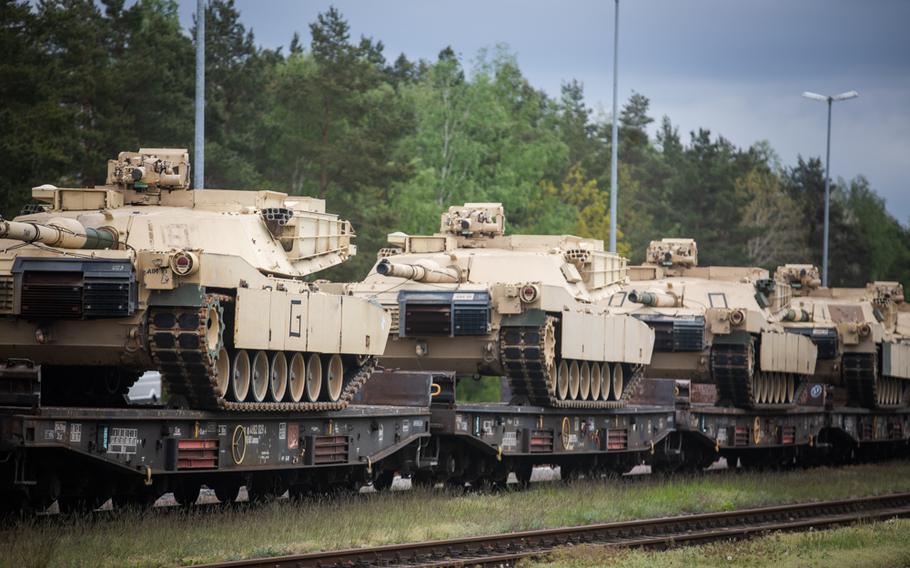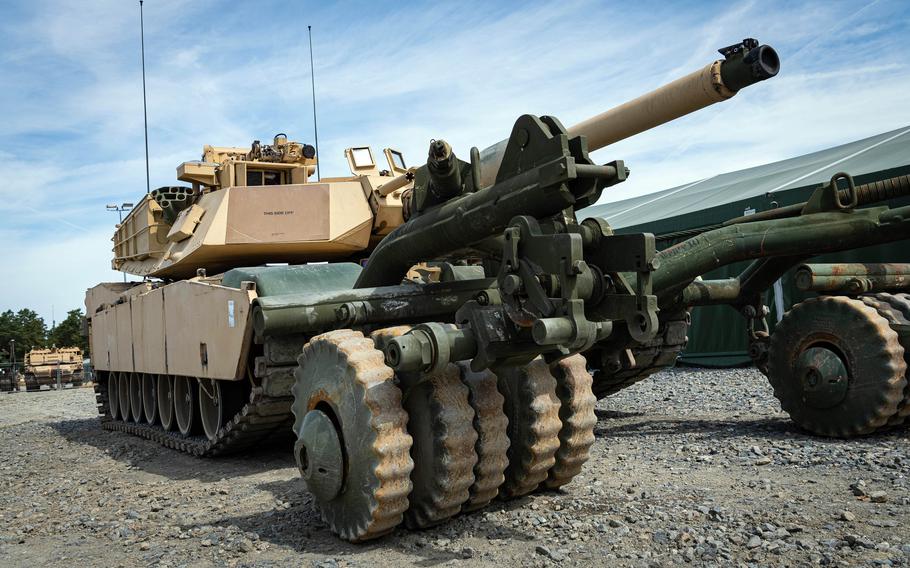
U.S. M1A1 Abrams tanks to be used to train Ukrainian soldiers arrive at Grafenwoehr, Germany, on May 12, 2023. About 200 Ukrainian soldiers are expected to complete their training in the coming weeks. (U.S. Army)
GRAFENWOEHR, Germany — A trio of M1 Abrams tanks with Ukrainian soldiers at the controls took turns firing at targets more than a mile away at this vast U.S. Army training area in Bavaria, the blasts echoing across the hilly expanse.
Roughly 200 Ukrainian trainees are here learning to operate and maintain the most advanced American battle tanks. They soon will be ready to use them against invading Russian forces in Ukraine, their U.S. military instructors said.
The Pentagon is set to deliver 31 refurbished Abrams tanks to Kyiv by fall, part of the roughly $40 billion in military aid the U.S. has given since the February 2022 start of the Russia-Ukraine war.
“As we continue to train Ukrainian armed forces on more and more advanced weapons systems, we continue to be amazed at how quickly they adapt,” U.S. European Command spokesman Capt. William Speaks said at the Grafenwoehr Training Area on Friday.
A small group of journalists were allowed a rare glimpse Friday into the instruction the Army-led Joint Multinational Training Group-Ukraine has been providing.
The soldiers were not made available for interviews, and military officials did not allow photos or video of the training.
The multinational group was established in 2015 to train Ukrainian soldiers in their home country but shifted to Germany after the full-scale Russian invasion.
Since then, more than 12,000 Ukrainians have been taught to use 36 American military systems, including Stryker and Bradley fighting vehicles, at Grafenwoehr and the nearby Hohenfels training area, officials said Friday. About 1,000 Ukrainian troops are now at the two sites, they said.
“They want to know as much detail as we can provide. They’re driven, inspired and all in,” a U.S. defense official involved in the Abrams training said of the troops. The American trainers were not allowed to be identified under the military’s ground rules.
In the only exercise observed, three stationary tanks fired 120mm cannons twice each at 10-foot-wide targets about 1.2 miles away. All but one shot hit the mark, which the officials indicated was a good performance.
An exercise later that evening involved shooting at targets while the tanks moved, they added. It was Week 8 of a 12-week crash course designed to get the troops back to the war as quickly as possible.

An M1A1 Abrams tank with an attached mine roller at Grafenwoehr Training Area, Germany, on July 14, 2023. (Phillip Walter Wellman/Stars and Stripes)
Training will continue after the soldiers leave Germany, and channels will be set up for crews to contact American experts should problems arise, a U.S. defense official said.
President Joe Biden at first was unwilling to transfer Abrams to Kyiv, with Pentagon officials saying the roughly $10 million tanks are too complex and expensive for the Ukrainians to operate, maintain and repair.
The Abrams runs on a jet turbine engine rather than a diesel engine like many other armored vehicles. It burns through fuel at a rate of about 2 gallons per mile, meaning a ready convoy of fuel trucks is necessary for it to operate.
While an Abrams can power through most challenging terrain, fuel trucks sometimes can’t. That’s one reason many analysts believe the German-made Leopard 2 is a more suitable tank for Ukraine.
But at the start of the year, German Chancellor Olaf Scholz insisted he would allow Leopards to be sent to Ukraine only if the U.S. also agreed to send Abrams tanks.
The tanks being used by the Ukrainians at Grafenwoehr arrived in Germany in May and aren’t the same ones that will be sent to the battlefield.
The combat tanks are being modified first, with sensitive technology being removed to prevent it from falling into the hands of Russian forces, USA Today reported in May.
Mark Cancian, a senior adviser at the Center for Strategic and International Studies, said he doesn’t expect the arrival of the Abrams tanks to have a decisive impact on the war.
“Thirty-one tanks, even very good tanks, are not going to make a big difference,” Cancian said in an email. “The main contribution is political, showing that the United States is willing to give Ukraine the most powerful weapons in its inventory.”
Maintaining and sustaining the Abrams also could prove burdensome for the Ukrainians, said Marina Miron, a researcher in war studies at King’s College London.
“It’s good to have additional tanks, but I don’t think the benefits of the Abrams here outweigh all the other problems associated with it,” Miron said in a phone interview.
The U.S. soldiers working with the Ukrainians in Germany downplayed concerns about the tank’s complexity, saying the training takes that into account.
In about a week, crews that have been operating each tank individually are expected to finish their qualifications and move on to live-fire training as platoons of four tanks and companies of about a dozen.
They’ll also work with other elements such as artillery, mortars and reconnaissance during the drills, officials said.
During the final two weeks, the troops will shift from Grafenwoehr to Hohenfels, where their tanks will be outfitted with a laser system and companies will have a simulated fight in which the opponents use Russian fighting tactics.
The drills are meant to be as realistic as possible, using scenarios that the Ukrainians could find themselves in very soon, the trainers said, although they acknowledged that when and how the Ukrainians use the Abrams tanks will be up to Kyiv.
At Camp Kasserine, an area at Grafenwoehr where Ukrainians and their U.S. instructors live in tents, about a half-dozen Ukrainian soldiers could be seen waiting under a shady tree. They all appeared to be in their late 30s or 40s.
A U.S. defense official said it was common to meet grandfathers out here training, including some working on the Abrams. One man training on a different system was 71 years old and said he signed up to ensure his grandchildren have a future, the official said.
Speaks, the EUCOM spokesman, said the Abrams training also should be seen as an investment for the future.
“This particular training is not just about the current fight,” he said. “This is an investment in Ukraine’s long-term security.”